|
Hiram Bingham, the American explorer who found the
ruins of Machu Picchu in 1911, wrote:
The Incas built a notable civilization in
western South America in the fifteenth and sixteenth centuries. The
center of their empire was in present-day Cuzco, Peru.
In the beginning the word Inca, which means
king or emperor, was the term applied only to the chief of that
remarkable people whose courage and genius for organization had enabled
them to conquer most of Peru, Ecuador, and Bolivia, as well as the
northern parts of Chile and Argentina. Then came the Spanish
conquistadors in the sixteenth century and applied the term to the
ruling class, members of the Inca's family and the nobles and priests
who governed the Inca Empire. Soon, however, they were all killed off
and by the end of the century scarcely one was to be found anywhere. The
builders of Machu Picchu were the descendants of generations of skilled
artisans, but those who directed the workmen were the Incas whose
capital for centuries was Cuzco.
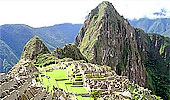
Strictly speaking, the first Inca was a
war-like chieftain of the Quichua tribe of Indians who ruled Cuzco about
1200 A.D. and was worshipped as a demi-god, the son of the Sun. It was
perhaps only a hundred years before the arrival of Pizarro and the
conquistadors that the ninth Inca, properly so called, extended the
Empire as far north as Ecuador and as far south as Argentina. As a
matter of fact the Inca Empire had just about reached its apogee and
passed its prime when the Spaniards landed. Had they arrived in the days
of the great Inca Pachacuti (ca. 1450) they would have received short
shrift. As it happened they arrived when the empire was weakened by a
long civil war.
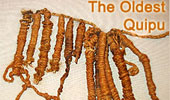
As there are no written records and the
interpretation of the quipus or knotted cords as well as the history of
the past depended on the memory or the imagination of the persons who
where interviewed by the first Spanish chroniclers, we cannot be certain
of dates or events. It appears likely that the development of such arts
and sciences as Agriculture, Metallurgy, Ceramics, Weaving and
Engineering took place chiefly in the centuries which preceded the first
Inca. There were many Peruvian tribes that had been independent nations
long enough, before they were conquered by the Incas, to develop
remarkable artistic ability in ceramics and
textiles.
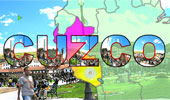
One of the most interesting places in the
world is Cuzco, the ancient capital of the Empire of the Incas. In the
days of the Spanish Conquest of Peru it was the largest city in America.
On a hill back of it is an old fortress, a place of refuge for
centuries. The northern wall of that fortress is perhaps the most
extraordinary structure built by ancient man in the Western Hemisphere.
In fact, as an achievement of engineering, it stands without parallel in
American antiquity. The smaller blocks in the wall weigh ten or twenty
tons. Larger blocks are estimated to weigh two hundred tons. A few of
the largest weigh three hundred tons! And yet are fitted accurately
together. There are no clamps. There was no cement used in constructing
the wall. The gigantic polygonal blocks cling so closely together that
is impossible to insert the point of a knife between them. An they were
brought from quarries more than a mile away where they were fashioned by
people using stone tools. They were moved over an inclined plane by
levers. The Incas had no iron or steel, but they had bronze crowbars of
great strength. They had no derricks or pulleys or wheels but they had
thousands of patient workers. The determination and the perseverance of
the builder stagger the imagination. It makes one admire the Incas and
wish to learn more about them.
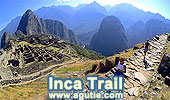
Source:
‘Lost City of the Incas, The Story of Machu
Picchu and its Builders’ by Hiram Bingham
The American explorer who found the ruins of Machu Picchu in 1911.
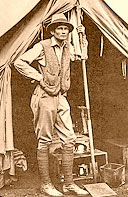
Hiram Bingham at Machu Picchu
The inspiration for Indiana Jones?
|